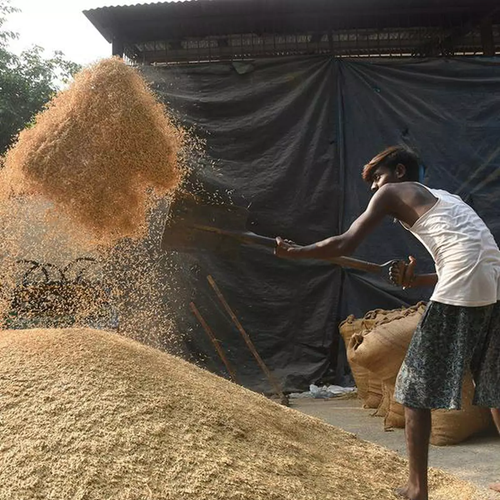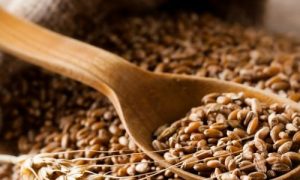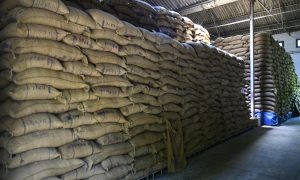Haryana, Rajasthan and Punjab farmers expect higher wheat yield this year

Farmers in Haryana, Punjab and Rajasthan are expecting at least seven to 10 per cent increase in yield of wheat this year due to favourable weather throughout January and the recent rains that brought temperature down.
They will likely provide requisite moisture over the next few days. However, any abnormal temperature increase in this month and March, particularly during the grain-filling stage, could offset their calculation and may even lower the production from last year.
“The current spell of rains is a much expected relief as it will save one round of irrigation. The cold conditions have helped the crop to come up very well this time,” said R S Rana, a farmer in Haryana, bordering Delhi, said and added that his decision to go for Pusa 1718 and got the planting completed in last week of October have been helpful.
Snowfall raises hopes
Another farmer, Amrik Singh Dhillon of Ludhiana, Punjab, said he has again sown PBW 826 variety and hopes to get higher yield this time from over 25 quintal/acre last year as the weather so far was very good. Besides, he expected that the current spell of snowfall in the Hills would not allow temperature to rise this month from normal level.
“My only concern is about some delay in sowing this year as I had planted wheat in last week of October in 2022 and around November 10 in 2023,” he said and added that there is no report of any pest attack from anywhere, so far.
Ashok Singh, of Hanumangarh and Sukhvider Pal Singh of Sri Ganganagar, both in Rajasthan, are also happy and expect a good harvest of wheat. “In our area, some farmers planted wheat even up to December 20 after uprooting cotton, though the majority of sowing started after the first week of November. The heading has started coming up in early sown crop, planted before November 7,” Pal Singh said.
Highest sowing in UP
The Agriculture Ministry Friday released the final sowing data of all Rabi crops for the 2023-24 season, which show that wheat acreage this year ended at 341.57 lakh hectares (lh) compared with 339.20 lh in 2022-23. Uttar Pradesh, the largest producer of wheat, has reported the highest sowing of over 101.41 lh, up by more than 4 per cent and it has helped offset lower coverage in Rajasthan and Maharashtra. The acreage in Punjab and Haryana is almost at par with last year.
The Government has fixed a target of 114 million tonnes for wheat production this year.
Even if the day temperature is one to two degree Celsius higher than normal, there is no worry for the crop provided the night is cooler, Gyanendra Singh, Director of Karnal-based Indian Institute of Wheat and Barley Research (IIWBR) had said last month.
IMD bulletin
According to latest Bulletin of India Meteorological Department (IMD), the maximum temperature in Haryana’s Ambala. Hisar, Rohtak and Chandigarh was one to two degree Celsius lower than normal. In Amritsar, Ludhiana and Patiala in Punjab, the maximum temperature was one to four degree Celsius below normal. In Rajasthan’s main wheat growing belt the maximum temperature was 3 degree Celsius below normal.
However, in Meerut, Aligarh and Shahjahanpur of western Uttar Pradesh, the maximum temperature was 0.4-0.9 degree Celsius above normal on February 3. In Gorakhpur, Hardoi and Bahraich of eastern Uttar Pradesh, the maximum temperature was 0.5-2.1 degree Celsius above normal.
In Punjab and Haryana, the minimum temperature was 3-6 degree Celsius above normal on February 4. In most of the places in Uttar Pradesh, too the minimum temperature was up to 3.2 degree Celsius above normal.
Meanwhile, the Agriculture Ministry data also showed that the area sown under all Rabi crops during the 2023-24 crop year (July-June) ended at 709.29 lh, a tad higher than 709.09 lh during 2022-23.
Winter-grown pulses acreage was 160.08 lh compared with 166.19 lh as gram (chana) acreage dropped to 104.74 lh from 110.71 lh. But lentil acreage rose to 19.57 lh from 18.52 lh.
Mustard acreage was 100.44 lh against 97.97 lh in the corresponding period of 2022-23. All rabi oilseeds acreage has been reported to be at 110.96 lh, up from 109.76 lh a year ago. Groundnut area, however, ended down at 4.88 lh from 5.68 lh.
Winter paddy acreage reached 39.29 lh against 40.37 lh a year ago. In coarse cereals, the sowing area was 57.38 lh from 53.57 lh. Jowar acreage up 25.17 lh from 22.37 lh and maize at 23.08 lh from 22.62 lh. Barley sowing is also up at 8.21 lh against 7.57 lh.
Source Link:https://www.thehindubusinessline.com/economy/agri-business/rabi-sowing-ends-wheat-up-pulses-down-temp-in-feb-mar-will-be-key-to-production/article67810655.ece














